状语从句教学案
- 格式:doc
- 大小:59.00 KB
- 文档页数:5
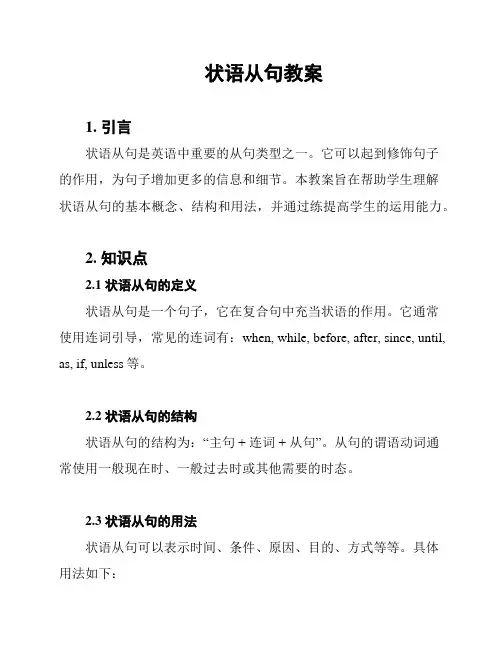
状语从句教案1. 引言状语从句是英语中重要的从句类型之一。
它可以起到修饰句子的作用,为句子增加更多的信息和细节。
本教案旨在帮助学生理解状语从句的基本概念、结构和用法,并通过练提高学生的运用能力。
2. 知识点2.1 状语从句的定义状语从句是一个句子,它在复合句中充当状语的作用。
它通常使用连词引导,常见的连词有:when, while, before, after, since, until, as, if, unless等。
2.2 状语从句的结构状语从句的结构为:“主句 + 连词 + 从句”。
从句的谓语动词通常使用一般现在时、一般过去时或其他需要的时态。
2.3 状语从句的用法状语从句可以表示时间、条件、原因、目的、方式等等。
具体用法如下:- 时间:when, while, before, after, since, until等。
Example: He went to bed after he finished his homework.- 条件:if, unless, provided that等。
Example: You can go out if you finish your work.- 原因:because, since, as等。
Example: I stayed at home because it was raining.- 目的:so that, in order that等。
Example: He studied hard so that he could pass the exam.- 方式:as, as if, as though等。
Example: She speaks English as if she were a native speaker.3. 练请根据下面的句子,完成相应的状语从句。
1. I will call you ________ I arrive in New York. (when)2. They stayed at the hotel ________ the storm passed. (until)3. She will go to the party ________ she finishes her work. (after)4. You can borrow my car ________ you promise to drive carefully. (if)5. ________ you work hard, you will succeed. (Unless)4. 总结通过本教案的研究,我们了解了状语从句的基本概念、结构和用法。
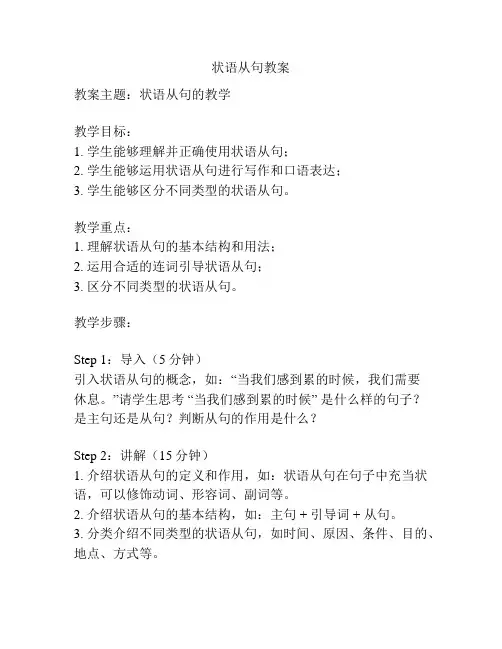
状语从句教案教案主题:状语从句的教学教学目标:1. 学生能够理解并正确使用状语从句;2. 学生能够运用状语从句进行写作和口语表达;3. 学生能够区分不同类型的状语从句。
教学重点:1. 理解状语从句的基本结构和用法;2. 运用合适的连词引导状语从句;3. 区分不同类型的状语从句。
教学步骤:Step 1:导入(5分钟)引入状语从句的概念,如:“当我们感到累的时候,我们需要休息。
”请学生思考“当我们感到累的时候” 是什么样的句子?是主句还是从句?判断从句的作用是什么?Step 2:讲解(15分钟)1. 介绍状语从句的定义和作用,如:状语从句在句子中充当状语,可以修饰动词、形容词、副词等。
2. 介绍状语从句的基本结构,如:主句 + 引导词 + 从句。
3. 分类介绍不同类型的状语从句,如时间、原因、条件、目的、地点、方式等。
Step 3:练习(20分钟)1. 提供一些例句让学生尝试判断其是否为状语从句,并指出属于哪种类型的状语从句。
2. 以小组或个人为单位进行练习,要求学生根据给定的句子构建合适的状语从句,要求考虑时间、原因、条件、目的、地点、方式等。
3. 练习口语表达,提供一些情景让学生运用状语从句进行交流,如:你什么时候会感到开心?可以用一个状语从句回答。
Step 4:总结(10分钟)1. 总结状语从句的要点和知识点;2. 让学生回顾并分享自己的学习收获和体会。
Step 5:拓展(5分钟)布置作业,要求学生写一篇短文,要求使用至少三个不同类型的状语从句。
教学资源:1. PowerPoint 展示或者黑板;2. 一些例句和练习题。
评估方式:1. 教师观察学生的课堂互动情况;2. 练习题的完成情况;3. 作业的质量和准确性。
备注:教案中的时间分配仅供参考,具体时间上可以根据教学进度合理调整。
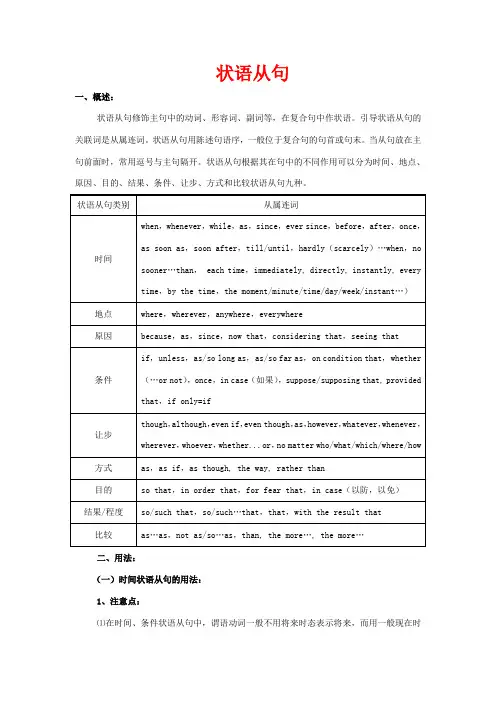
状语从句一、概述:状语从句修饰主句中的动词、形容词、副词等,在复合句中作状语。
引导状语从句的关联词是从属连词。
状语从句用陈述句语序,一般位于复合句的句首或句末。
当从句放在主句前面时,常用逗号与主句隔开。
状语从句根据其在句中的不同作用可以分为时间、地点、原因、目的、结果、条件、让步、方式和比较状语从句九种。
二、用法:(一)时间状语从句的用法:1、注意点:⑴在时间、条件状语从句中,谓语动词一般不用将来时态表示将来,而用一般现在时态代替一般将来时态,用一般过去时态代替过去将来时态,用现在完成时态代替将来完成时态。
如:When he comes here,I will let you know. When I have finished reading the book,I will tell you.注意:when可以引导时间状语从句,还可以引导宾语、主语等名词性从句;if可以引导条件状语从句,也可以引导宾语从句(引导条件状语从句时,意为“如果,假如”,引导宾语从句时,意为“是否”);注意当它们引导时间和条件状语从句时,要用一般现在时态表示将来,引导宾语等名词性从句时,仍然要用一般将来时态表示将来。
如:When he comes here, please tell me. W hen he will come here hasn’t been decided yet.If he has any questions,he will come to ask me. Tell me if you will go to school tomorrow.(2)时间、条件、方式、让步等状语从句常常可以转换成省略形式或简单句句子成分。
①when,while,as,if,though,as if等引导时间、条件、方式、让步等状语从句时,若从句和主句的主语一致或主句的主语是it且含有be动词时,可以将从句中的主语连同后面的be动词一起省略。
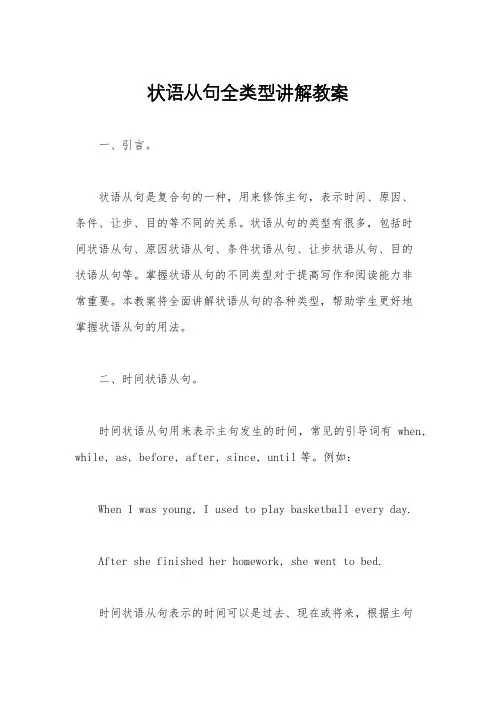
状语从句全类型讲解教案一、引言。
状语从句是复合句的一种,用来修饰主句,表示时间、原因、条件、让步、目的等不同的关系。
状语从句的类型有很多,包括时间状语从句、原因状语从句、条件状语从句、让步状语从句、目的状语从句等。
掌握状语从句的不同类型对于提高写作和阅读能力非常重要。
本教案将全面讲解状语从句的各种类型,帮助学生更好地掌握状语从句的用法。
二、时间状语从句。
时间状语从句用来表示主句发生的时间,常见的引导词有when, while, as, before, after, since, until等。
例如:When I was young, I used to play basketball every day.After she finished her homework, she went to bed.时间状语从句表示的时间可以是过去、现在或将来,根据主句的时态来确定。
需要注意的是,如果主句是一般现在时,时间状语从句通常使用一般过去时表示过去的动作或状态;如果主句是一般过去时,时间状语从句通常使用过去完成时表示更早的过去。
三、原因状语从句。
原因状语从句用来表示主句发生的原因,常见的引导词有because, since, as, for, now that等。
例如:Because it was raining, we stayed at home.Since she was tired, she went to bed early.原因状语从句表示的原因可以是客观原因或主观原因,需要根据具体语境来确定。
需要注意的是,原因状语从句通常放在主句之前,用逗号隔开时则可以放在主句之后。
四、条件状语从句。
条件状语从句用来表示主句发生的条件,常见的引导词有if, unless, provided that, on condition that等。
例如:If it rains tomorrow, we will stay at home.Provided that you finish your homework, you can go outto play.条件状语从句表示的条件可以是真实的、非真实的或虚拟的,需要根据具体语境来确定。
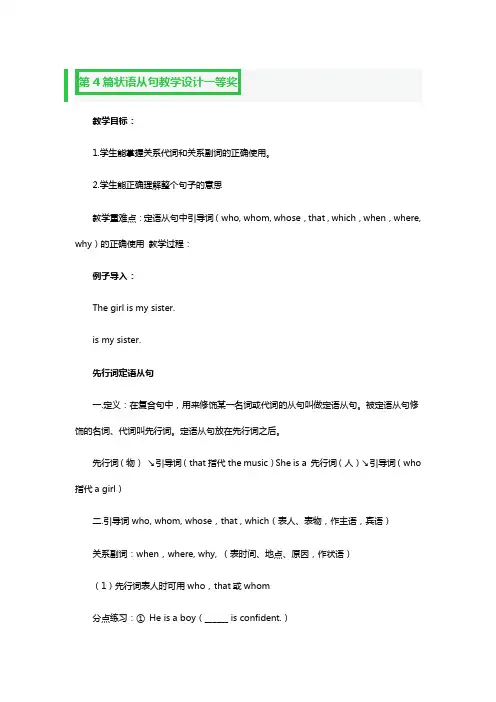
第4篇状语从句教学设计一等奖教学目标:1.学生能掌握关系代词和关系副词的正确使用。
2.学生能正确理解整个句子的意思教学重难点:定语从句中引导词(who, whom, whose,that , which,when,where, why)的正确使用教学过程:例子导入:The girl is my sister.is my sister.先行词定语从句一.定义:在复合句中,用来修饰某一名词或代词的从句叫做定语从句。
被定语从句修饰的名词、代词叫先行词。
定语从句放在先行词之后。
先行词(物)↘引导词(that指代the music)She is a 先行词(人)↘引导词(who 指代a girl)二.引导词who, whom, whose,that , which(表人、表物,作主语,宾语)关系副词:when,where, why, (表时间、地点、原因,作状语)(1)先行词表人时可用who,that或whom分点练习:①He is a boy(______ is confident.)主语②(介词提前)③He is the teacher ( ______ you are waiting for.)宾语归纳总结:当先行词是人:①引导词在句中作主语,引导词用who,that③引导词在从句中作宾语,引导词用who/whom小试牛刀:1.Is this the man with ______ you went to the zoo yesterday?A. whoB. whomC. which2.He is a man ( _______ we can learn).A. whomB. from whichC. from whomlearn from【2013广东湛江】25. —Look! That is the woman I met yesterday.—Oh? She’s my aunt.A. whatB. whoC. whereD. when【2013广东】45. The young lady ______ is interviewing Lin Zhixuan about the program I am a singer is from 21st Century Talent Net.A. whoB. whomC. whichD. whose(2)whose的使用名词A. whichB. whoseC. that引导词后面有名词(表所属)时,引导词用whose(3)先行词表物时,用that或whichthat与which的区别:that和which都可表物,一般可互换,但下列情况只用that1. I’m sure she has something ______ you can borrow.A. thatB. which⑴先行词为:that 2. I’ve read ⑵先行词被all, every, no, some, any, little, much 等修饰时4. This is the only book that belongs to him.⑷先行词被the only, the very, the same, the best, the last等修饰时6. There is a book on the desk belongs to Tom. 桌子上那本书是汤姆的⑹在7 Who is the girl ______ spoke to you just now?Which is the car _____ was made in China?A. thatB. whoC. which[7].当主句that巩固练习:Who is the man ______ I saw yesterday.小试牛刀:I like the music _______ he writes.A. /B. whoC. why D when只用which的情况:1.This is the house in ______ he lives.A. thatB. whichC. who1.先行词是物,且介词提前用whichThe school (______ my father works) looks very beautiful.(my father works in the school)A. whichB. in thatC. in which对比:Is this the man with ______ you went to the zoo yesterday?A. whoB. whomC. which先行词是人,且介词提前用_______.2.先行词(物)与引导词之间有逗号隔开(非限制性定语从句),用which 2.He lives in a house, _______ has many trees around it.A. thatB. whichC. who3.先行词为that, those时,用which3.What’在桌子底下的那些东西是什么?【2011广东】44. The first thing _____ my brother is going to do this afternoon is to write a letter.A. whichB. thatC. whyD. who【2011?广州】The story ______ I read the newspaper was about a common problem among teenagers.A. whoseB. whoC. thatD. where【2013安徽】49. I still remember the college and the teachers_____________I visited in London years ago.A. whatB. whoC. thatD. which(4)关系副词when, where,why的用法:先行词是一个表示时间的词如:time, hour, day, month, year时,其所对应的关系词如在定语从句中作时间状语(不充当从句的主语或宾语),则用关系副词when。
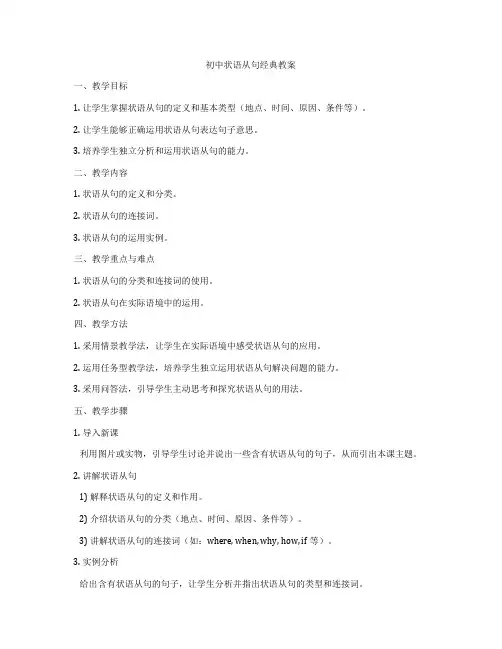
初中状语从句经典教案一、教学目标1. 让学生掌握状语从句的定义和基本类型(地点、时间、原因、条件等)。
2. 让学生能够正确运用状语从句表达句子意思。
3. 培养学生独立分析和运用状语从句的能力。
二、教学内容1. 状语从句的定义和分类。
2. 状语从句的连接词。
3. 状语从句的运用实例。
三、教学重点与难点1. 状语从句的分类和连接词的使用。
2. 状语从句在实际语境中的运用。
四、教学方法1. 采用情景教学法,让学生在实际语境中感受状语从句的应用。
2. 运用任务型教学法,培养学生独立运用状语从句解决问题的能力。
3. 采用问答法,引导学生主动思考和探究状语从句的用法。
五、教学步骤1. 导入新课利用图片或实物,引导学生讨论并说出一些含有状语从句的句子,从而引出本课主题。
2. 讲解状语从句1) 解释状语从句的定义和作用。
2) 介绍状语从句的分类(地点、时间、原因、条件等)。
3) 讲解状语从句的连接词(如:where, when, why, how, if等)。
3. 实例分析给出含有状语从句的句子,让学生分析并指出状语从句的类型和连接词。
4. 练习巩固设计一些练习题,让学生填空或改写句子,运用状语从句。
5. 拓展提高让学生举例说明状语从句在实际生活中的应用,分享自己的经验。
6. 总结反馈对本节课的内容进行总结,回答学生的疑问,收集学生的反馈意见。
六、课后作业1. 复习本节课所学的状语从句知识。
2. 完成课后练习题,巩固所学内容。
3. 尝试在写作或口语表达中运用状语从句。
七、教学评价1. 课堂参与度:学生是否能积极参与课堂讨论和练习。
2. 作业完成情况:学生是否能正确完成课后练习。
3. 实际应用能力:学生是否能将在课堂上学到的状语从句知识运用到实际语境中。
4. 自主学习能力:学生是否能独立分析和运用状语从句。
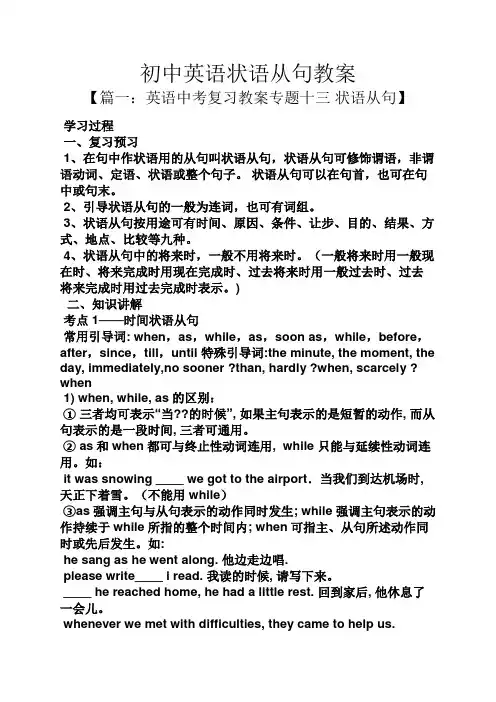
初中英语状语从句教案【篇一:英语中考复习教案专题十三状语从句】学习过程一、复习预习1、在句中作状语用的从句叫状语从句,状语从句可修饰谓语,非谓语动词、定语、状语或整个句子。
状语从句可以在句首,也可在句中或句末。
2、引导状语从句的一般为连词,也可有词组。
3、状语从句按用途可有时间、原因、条件、让步、目的、结果、方式、地点、比较等九种。
4、状语从句中的将来时,一般不用将来时。
(一般将来时用一般现在时、将来完成时用现在完成时、过去将来时用一般过去时、过去将来完成时用过去完成时表示。
)二、知识讲解考点1——时间状语从句常用引导词: when,as,while,as,soon as,while,before,after,since,till,until 特殊引导词:the minute, the moment, the day, immediately,no sooner ?than, hardly ?when, scarcely ? when1) when, while, as的区别:①三者均可表示“当??的时候”, 如果主句表示的是短暂的动作, 而从句表示的是一段时间, 三者可通用。
② as和when都可与终止性动词连用, while 只能与延续性动词连用。
如:it was snowing ____ we got to the airport.当我们到达机场时, 天正下着雪。
(不能用 while)③as强调主句与从句表示的动作同时发生; while强调主句表示的动作持续于while所指的整个时间内; when可指主、从句所述动作同时或先后发生。
如:he sang as he went along. 他边走边唱.please write____ i read. 我读的时候, 请写下来。
____ he reached home, he had a little rest. 回到家后, 他休息了一会儿。
whenever we met with difficulties, they came to help us.i got in touch with him immediately i received his letter.my sister came directly she got my message.every time i catch a cold, i have pain in my back.如果把no sooner, hardly, scarcely, barely置于句首,它所连带的这部分要倒装,如: no sooner had she heard the news than she fainted.(she had no sooner heard the news than she fainted.)考点2——条件状语从句常用引导词: if,unless,(if not)特殊引导词:as/so long as,on condition that① we’ll start our project ___ the president agrees.② you will certainly succeed ____ ___ ___ you keep on trying.要点: 引导条件状语从句的连词有if(如果)、unless(除非)等, unless 在意义上相当于if?.not。

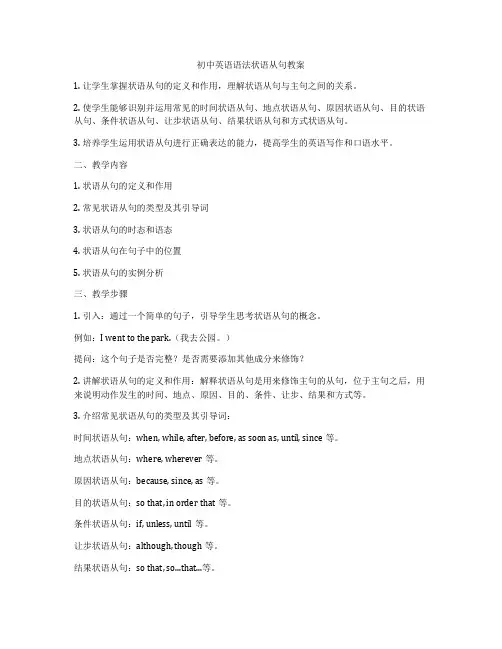
初中英语语法状语从句教案1. 让学生掌握状语从句的定义和作用,理解状语从句与主句之间的关系。
2. 使学生能够识别并运用常见的时间状语从句、地点状语从句、原因状语从句、目的状语从句、条件状语从句、让步状语从句、结果状语从句和方式状语从句。
3. 培养学生运用状语从句进行正确表达的能力,提高学生的英语写作和口语水平。
二、教学内容1. 状语从句的定义和作用2. 常见状语从句的类型及其引导词3. 状语从句的时态和语态4. 状语从句在句子中的位置5. 状语从句的实例分析三、教学步骤1. 引入:通过一个简单的句子,引导学生思考状语从句的概念。
例如:I went to the park.(我去公园。
)提问:这个句子是否完整?是否需要添加其他成分来修饰?2. 讲解状语从句的定义和作用:解释状语从句是用来修饰主句的从句,位于主句之后,用来说明动作发生的时间、地点、原因、目的、条件、让步、结果和方式等。
3. 介绍常见状语从句的类型及其引导词:时间状语从句:when, while, after, before, as soon as, until, since等。
地点状语从句:where, wherever等。
原因状语从句:because, since, as等。
目的状语从句:so that, in order that等。
条件状语从句:if, unless, until等。
让步状语从句:although, though等。
结果状语从句:so that, so...that...等。
方式状语从句:as, as if, as though等。
4. 讲解状语从句的时态和语态:状语从句的时态和语态应与主句保持一致。
5. 讲解状语从句在句子中的位置:状语从句通常位于主句之后,但有时也可以放在主句之前,用逗号与主句分隔。
6. 实例分析:分析一些含有状语从句的句子,让学生明确状语从句的作用和用法。
例如:When I came home, my parents were watching TV.(当我回家时,我的父母正在看电视。
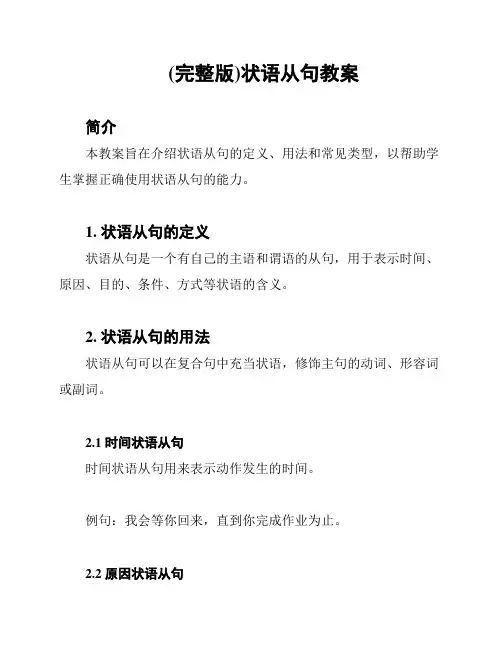
(完整版)状语从句教案简介本教案旨在介绍状语从句的定义、用法和常见类型,以帮助学生掌握正确使用状语从句的能力。
1. 状语从句的定义状语从句是一个有自己的主语和谓语的从句,用于表示时间、原因、目的、条件、方式等状语的含义。
2. 状语从句的用法状语从句可以在复合句中充当状语,修饰主句的动词、形容词或副词。
2.1 时间状语从句时间状语从句用来表示动作发生的时间。
例句:我会等你回来,直到你完成作业为止。
2.2 原因状语从句原因状语从句用来表示主句中的动作的原因或理由。
例句:因为天气太冷,所以我们取消了野餐计划。
2.3 目的状语从句目的状语从句用于表示主句中的动作的目的或意图。
例句:我来这里是为了研究更多的知识。
2.4 条件状语从句条件状语从句用来表示主句中的动作发生的条件。
例句:如果明天下雨,我们就取消郊游活动。
2.5 方式状语从句方式状语从句用来表示主句中的动作发生的方式或方法。
例句:她以一种非常温柔地方式对待孩子们。
3. 练请在下列句子中选择正确的状语从句填空:1. 我会等你回来,______你完成作业为止。
A. 除非B. 既然C. 因为2. 她去超市买了很多东西,______家里没有食物了。
A. 因此B. 只要C. 不管3. 如果你迟到了,______开车去学校。
A. 我们会B. 我会C. 我们不会参考答案:1. A2. A3. B结语通过学习本教案,希望学生们能够理解并正确运用状语从句,提高英语写作和口语表达的能力。
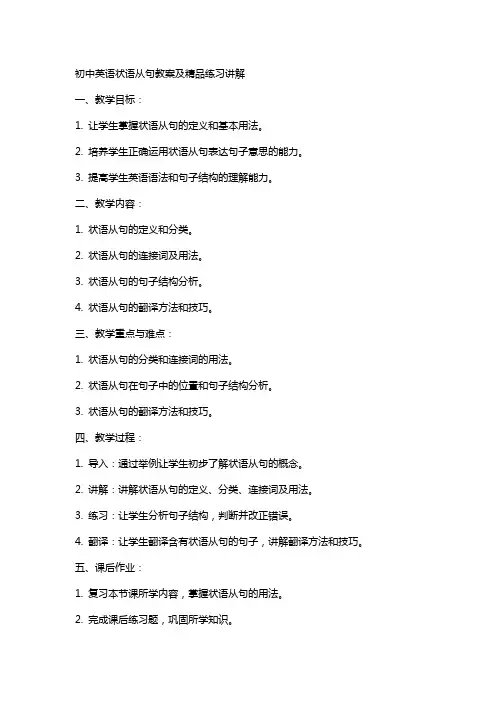
初中英语状语从句教案及精品练习讲解一、教学目标:1. 让学生掌握状语从句的定义和基本用法。
2. 培养学生正确运用状语从句表达句子意思的能力。
3. 提高学生英语语法和句子结构的理解能力。
二、教学内容:1. 状语从句的定义和分类。
2. 状语从句的连接词及用法。
3. 状语从句的句子结构分析。
4. 状语从句的翻译方法和技巧。
三、教学重点与难点:1. 状语从句的分类和连接词的用法。
2. 状语从句在句子中的位置和句子结构分析。
3. 状语从句的翻译方法和技巧。
四、教学过程:1. 导入:通过举例让学生初步了解状语从句的概念。
2. 讲解:讲解状语从句的定义、分类、连接词及用法。
3. 练习:让学生分析句子结构,判断并改正错误。
4. 翻译:让学生翻译含有状语从句的句子,讲解翻译方法和技巧。
五、课后作业:1. 复习本节课所学内容,掌握状语从句的用法。
2. 完成课后练习题,巩固所学知识。
3. 收集含有状语从句的句子,进行翻译和分析。
注意事项:1. 教学过程中要注意举例生动、贴近生活,激发学生的学习兴趣。
2. 针对不同程度的学生,适当调整教学难度,确保教学质量。
3. 注重培养学生的语法分析和运用能力,提高他们的英语水平。
六、教学策略与方法:1. 采用情景教学法,通过设定真实的生活场景,让学生在实际语境中学习和运用状语从句。
2. 使用任务型教学法,设计各种练习任务,让学生在完成任务的过程中掌握状语从句的用法。
3. 采用合作学习法,鼓励学生分组讨论,共同分析句子结构和翻译方法。
4. 运用多媒体教学手段,如PPT、视频等,丰富教学内容,提高学生的学习兴趣。
七、教学评价:1. 课堂表现:观察学生在课堂上的参与程度、发言情况和语法运用准确性。
2. 课后作业:检查学生完成作业的质量,包括语法、句子结构和翻译等方面。
3. 单元测试:定期进行单元测试,评估学生对状语从句知识的掌握程度。
4. 学生互评:鼓励学生相互评价,共同提高英语水平。
八、教学计划:1. 第一周:讲解状语从句的定义和分类。
初中状语从句专项教案教学目标:1. 学生能够理解状语从句的概念和作用。
2. 学生能够识别和运用不同类型的状语从句。
3. 学生能够正确连接主句和状语从句。
4. 学生能够运用状语从句表达具体的时间、地点、原因、条件等。
教学重点:1. 状语从句的连接词。
2. 不同类型状语从句的用法。
教学难点:1. 正确使用状语从句连接词。
2. 区分不同类型状语从句的用法。
教学准备:1. PPT展示不同类型状语从句的例句。
2. 练习题。
教学过程:一、导入(5分钟)1. 引导学生回顾句子成分的知识,让学生明白状语从句在句子中的作用。
2. 提问:什么是状语从句?状语从句在句子中起到什么作用?二、新课讲解(15分钟)1. 讲解状语从句的概念:状语从句是句子的一部分,用来修饰主句,表示时间、地点、原因、条件等。
2. 讲解状语从句的连接词:根据不同的状语从句类型,使用不同的连接词。
如:when (时间)、where(地点)、why(原因)、if(条件)等。
3. 举例讲解不同类型的状语从句:a. 时间状语从句:e.g. When I got home, I found my phone was missing.b. 地点状语从句:e.g. Wherever you go, you will find friends.c. 原因状语从句:e.g. Because it was raining, we cancelled our trip.d. 条件状语从句:e.g. If it doesn't rain tomorrow, we will go out for a picnic.三、课堂练习(10分钟)1. 让学生独立完成练习题,巩固所学知识。
2. 讲解练习题,回答学生疑问。
四、总结与拓展(5分钟)1. 让学生总结状语从句的连接词和用法。
2. 提问:状语从句可以放在主句的前面、中间还是后面?为什么?3. 拓展:引导学生思考状语从句在实际生活中的应用,如何用状语从句表达具体的时间、地点、原因、条件等。
状语从句的教学设计简介本教学设计旨在帮助学生理解和正确运用状语从句。
通过有趣且互动的教学活动,学生将能够掌握状语从句的定义、分类和用法,并能将其运用到实际的语境中。
本教学设计适用于初中阶段的英语教学。
教学目标- 了解状语从句的定义和基本特点- 掌握常见的状语从句分类和使用方式- 能够在实际语境中正确运用状语从句教学内容和步骤步骤一:引入- 使用图片或视频引入状语从句的概念,激发学生的研究兴趣。
- 介绍状语从句的定义和基本特点,强调它在句子中的作用和功能。
步骤二:分类和例子- 分类介绍不同类型的状语从句,包括时间状语从句、条件状语从句、原因状语从句、目的状语从句等。
- 分组活动:将学生分成几个小组,让每个小组负责一个状语从句分类,要求他们查找并分享几个有代表性的例子。
步骤三:实例解析- 给学生提供几个有状语从句的实例句子。
- 与学生一起分析每个句子中的状语从句,讨论它的类型和作用。
步骤四:小练- 给学生一些有状语从句的句子,要求他们找出其中的状语从句并判断其类型。
- 在小组内进行讨论和答案的分享。
步骤五:应用活动- 分组活动:给每个小组一个具体情境或故事情节,要求他们在自己的故事中使用状语从句来描述时间、条件、原因等。
- 让每个小组将他们的故事呈现给其他小组或全班,展示他们的创意和正确运用状语从句的能力。
教学评估和反馈- 在步骤四的小练中,通过观察学生的表现和答案的准确性来评估他们对状语从句的理解程度。
- 在应用活动中,观察学生使用状语从句的能力和创造力,并给予积极的反馈和指导。
拓展延伸- 鼓励学生在阅读和写作中积极运用状语从句,提高他们的语言表达能力。
- 引导学生自主研究更多复杂的状语从句,如比较状语从句、方式状语从句等。
通过以上的教学设计和活动,学生将能够全面理解和运用状语从句,提升他们的语言能力和交际能力。
同时,通过互动和合作的学习方式,激发学生主动学习的兴趣和动力。
教案状语从句初中课程目标:1. 学生能够理解状语从句的概念和作用;2. 学生能够识别和运用状语从句的不同类型;3. 学生能够在句子中正确使用状语从句。
教学内容:1. 状语从句的定义和作用;2. 状语从句的类型:地点状语从句、时间状语从句、原因状语从句、条件状语从句等;3. 状语从句的连接词:where、when、why、if、until等。
教学步骤:一、导入(5分钟)1. 引导学生回顾所学过的定语从句和宾语从句,复习其概念和用法;2. 提问:我们已经学习了定语从句和宾语从句,那么有没有同学听说过状语从句呢?什么是状语从句呢?二、新课讲解(15分钟)1. 讲解状语从句的定义和作用:状语从句是用来修饰动词、形容词、副词或整个句子的从句,它起到状语的作用;2. 讲解状语从句的类型:地点状语从句、时间状语从句、原因状语从句、条件状语从句等;3. 讲解状语从句的连接词:where(在哪里)、when(什么时候)、why(为什么)、if (如果)、until(直到)等;4. 举例讲解并让学生跟读不同类型的状语从句。
三、课堂练习(15分钟)1. 让学生分组,每组编写一个含有状语从句的句子,并展示给其他组;2. 让学生互相纠正和评价,教师进行指导和讲解;3. 让学生在小组内互相练习使用状语从句,加强理解和运用。
四、课堂小结(5分钟)1. 教师引导学生总结本节课所学的内容,包括状语从句的定义、类型和连接词等;2. 强调状语从句在句子中的作用和重要性;3. 提醒学生要注意状语从句的使用时机和位置。
五、作业布置(5分钟)1. 让学生回家后编写三个含有不同类型状语从句的句子,并写在作业本上;2. 要求学生在句子中正确使用状语从句,并注意连接词的使用。
教学反思:本节课通过讲解和练习,让学生了解了状语从句的概念、类型和连接词等知识。
在课堂练习环节,学生能够分组编写含有状语从句的句子,并在小组内进行练习和展示。
但在练习过程中,发现部分学生对状语从句的运用还存在一定的困难,需要进一步加强指导和练习。
状语从句(2h)教学目标:掌握9大状语从句及其中重要得引导词与句型。
由于高考中状语从句经常与从句得时态语态,动词短语得搭配,以及状语从句得省略,虚拟语气与倒装一起考查。
因此必须掌握好:1 时间状语从句中各种引导词引导得主句与从句得时态得判断2 地点状语从句中表示抽象含义时从句必须在主句之前3 原因状语从句中because,as,now that得位置问题4 目得状语从句中得so that与在结果状语从句中得区分5 结果状语从句中得so/such…that…得特殊结构及其倒装6 条件状语从句中得if,unless得用法7 方式状语从句中得虚拟语气得用法8 让步状语从句中得as, though做引导词时得倒装用法教学重点:1 掌握常用得状语从句中得引导词2 判断状语从句中得时态3 状语从句中得倒装情况:no sooner…than, hardly/scarcely…when, not…until用于句首时得倒装;结果状语从句中so/such置于句首时得倒装情况;as/though引导得让步状语从句得倒装情况4 as if/though引导得方式状语从句中得虚拟语气教学进程:导入:状语从句在句子中作状语,修饰谓语。
㈠时间状语从句⒈回顾有哪些词可以引导时间状语从句—when, while, as表示“当…时”; immediately, instantly, as soon as, directly, the moment, no sooner than, hardly when, scarcely when, once表示“一…就…”; till, until, not until 表示“直到…才”;before 表示“还没来得及…就…”,“不到…就…”;since 表示“自从…”;every time, each time, next time, the first time, any time, all the time表示“每当…”,“每次…”,“下次…”等等⒉状语从句中得时态得判断方法:⑴过去,现在,将来⑵延续性与非延续性/时间点与时间段⑶主从句中得谓语动词得先后关系⑷判断开始时间与截止时间⒊when, while, as都可以表示主从句动作同时进行(口头造句举例)如:when the music fades away, people tide away、She sat there alone while others were all dancing、He dances joyfully as the music goes、当主句动词为短暂性,从句动词用延续性动词得进行时态表示一段时间内得动作时,三个词可互换。
状语从句教学案状语从句是复合句中的一种从句类型,用来修饰主句中的动词、形容词或副词,对其进行详细说明。
在英语学习中,状语从句的运用是提高语言表达能力的关键之一。
本教学案将着重介绍状语从句的定义、分类及正确运用的方法,帮助学生掌握并灵活运用状语从句。
一、引入(100字)1. 标题:状语从句教学案2. 格式:教学案状语从句是英语中的一个重要知识点,也是提高语言表达能力的重要手段。
通过学习状语从句,可以丰富语言的表达方式,提高语言表达的准确性和流畅度。
本教学案将以具体例子和练习为主,帮助学生掌握状语从句的相关知识和正确运用方法。
二、知识点介绍(800字)1. 状语从句的定义状语从句是一个从属于主句的句子,主要用来修饰主句中的动词、形容词或副词,对其进行详细说明。
状语从句通常由连词引导,位置可以在主句之前、之中或之后。
2. 状语从句的分类a) 时间状语从句:用来表示主句动作发生的时间,常用的连词有when、while、before等。
b) 地点状语从句:用来表示主句动作发生的地点,常用的连词有where、wherever等。
c) 原因状语从句:用来表示主句动作的原因,常用的连词有because、since、as等。
d) 条件状语从句:用来表示主句动作的条件,常用的连词有if、unless等。
e) 目的状语从句:用来表示主句动作的目的,常用的连词有so that、in order that等。
f) 结果状语从句:用来表示主句动作的结果,常用的连词有so...that、such...that等。
g) 方式状语从句:用来表示主句动作的方式,常用的连词有as、as if等。
3. 状语从句的引导词的使用不同类型的状语从句需要使用不同的引导词,根据状语从句的分类掌握相应的引导词的用法非常重要。
同时,学生还需要注意一些特殊状语从句的引导词的用法,如时间状语从句中的"when"和"while"的区别等。
状语从句初中教案教学目标:1. 学生能够理解状语从句的概念和作用。
2. 学生能够识别和运用状语从句来修饰动词、形容词、副词或整个句子。
3. 学生能够正确使用状语从句来表达时间、地点、原因、条件等概念。
教学重点:1. 状语从句的类型和结构。
2. 状语从句的运用和练习。
教学难点:1. 状语从句的时态和语态。
2. 状语从句的连接词的使用。
教学准备:1. PPT或黑板,用于展示状语从句的类型和例句。
2. 练习题,用于巩固学生的理解和运用。
教学过程:Step 1:引入引导学生回顾句子中的成分,让学生注意到有些成分可以修饰动词、形容词、副词或整个句子。
Step 2:讲解状语从句解释状语从句的概念和作用,即状语从句是用来修饰动词、形容词、副词或整个句子的从句。
介绍状语从句的类型,包括时间状语从句、地点状语从句、原因状语从句和条件状语从句等。
举例说明每种状语从句的用法和结构,如:- 时间状语从句:When I wake up, I usually have coffee.- 地点状语从句:Wherever you go, you will find friends.- 原因状语从句:Because it is raining, we will cancel the trip.- 条件状语从句:If you finish your homework, you can go out.Step 3:练习让学生练习识别和运用状语从句,提供一些练习题,如:1. 选出正确的状语从句连接词填空:- ___ I finish my work, I will go out. (When, Because, If)- ___ you come back, please call me. (Wherever, Whenever, Why)2. 完成句子,使用状语从句来修饰动词、形容词、副词或整个句子:- ___ I get home, I will send you the email.- She is very happy, ___ she got good news.Step 4:总结和复习让学生总结状语从句的类型和用法,回答一些问题,如:- 状语从句是什么?- 状语从句可以用来修饰哪些成分?- 状语从句的连接词有哪些?最后,提醒学生注意状语从句的时态和语态的使用,以及正确选择连接词。
英语高考专题复习讲与练13状语从句一、考点聚焦1、时间状语从句(2)引导时间状语从句的连接词除上述外还有:①till, not … until …, until, before, sinceDon’t get off the bus unt il it has stopped.He waited for his father until(till)it was twelve o’clock.before 的有关句型It will be +段时间+before+从句(一般现在时)“要过…..才”It will be five years before he returns from England.It won’t be long before +从句(一般现在时)“不久…就会”It won’t be long before he recovers from the injury.It was 3 years before he regained the love from his parents.It wasn’t long before the whole nation rose up to drive the enemy out of their country.He rang off before I could answer it.②hardly / scarcely … when, no sooner … th an, as soon as once表示“一……就”As soon as I have finished it , I’ll give yu a call.Once you show any fear, he will attack you.We had hardly got / Hardly had we got into the country when it began to rain.No sooner had he arrived / He had no sooner arrived than she started complaining.③directly, immediately, the moment, the minute that… 一……就He made for the door directly he heard the knock.④each time, every time, next time, any time ,by the timeEach time he came to my city, he would call on me.⑤the day, the time, the first(second, third …)time, the spring (summer, autumn, winter)His mother died the spring he returned.注意:表示未来情况,主句用将来时,从句用现在时。
在时间和条件从句中,主句是一般将来时,从句通常用一般现在时表示一般将来或者用现在完成表示将来完成。
e.g. We’ll go outing if it doesn’t rain tomorr ow.I’ll write to you as soon as I get to Shanghai.Don’t get off the bus until the bus has stopped .2、让步状语从句(1)although与though可以引导让步状语从句,不能与but连用,但可以与yet连用。
Although they are poor,(yet)they are warm-hearted.(2)even if或even though引导让步状语从句,表示“即使”,“纵然”,用来使人注意下文所强调内容的性质。
I’ll get there even if(though)I have to sell my house to get enough money to go by air.(3)no matter后接上who、what、where、how等疑问词,也可以在这类疑问词后面加上ever构成whoever、whatever、wherever、however等。
Don’t trust him, no matter what / whatever he says.Whoever breaks the law will be published.No matter how hard the work is, you’d better try to do it well.(4)as也可以引导让步状语从句。
要用倒装。
Child as(though)he is, he knows a lot.Much as I like it, I won’t buy.Try as he would, he couldn’t lift the heavy box.(5)whether…..or(无论……….与否)无论他是否愿意参与这次活动,我们也要坚持直到成功.__________________________________________________________________________3、原因状语从句:because, for, as, since, now that(1)表示不知道的原因时用because,即说话人认为听话人不知道,因此because从句是全句最重要的部分,通常它被置于主句之后。
You want to know why I’m leaving? I’m leaving because I’m full.for虽然表示不知道的原因,但其语气较because要弱得多,是可说可不说的话,它只能置于主句之后,这时,for是并列连词。
如果不是因果关系,而是对前面主句的内容加以解释或推断时,只能用for。
如:It’s morning now, for the birds are singing.(很显然,鸟叫不可能是“现在已是早上”的原因。
)(2)表示已经知道的原因时用as或since,即某种原因在说话人看来已经很明显,或已为听话人所熟悉,因此它是句中不很重要的部分。
since要比as正式一些,它们通常被置于语句之前,但有时却相反。
Seeing all of the children already seated, he said,“Since everyone is here, let’s start.”(3)下列情况下只能使用because:①在回答why的问句时;②在用于强调句型时;③被not所否定时。
4、地点状语从句:where, whereverMake a mark wherever you have any questions.We will go where the Party directs us.5、目的状语从句:so, that, so that, in order that, in case(以防,以免)等.注意:目的状语从句的谓语动词常与情态动词连用,否则可能是结果状语从句。
不可置于句首。
She has bought the book in order that she could follow the TV lessons.He left early in case he should miss the train.6、结果状语从句:that, so that, so … that, such … that …注意:so + 形容词/副词+ that从句;such +名词+ that从句。
7、方式状语从句:as, as if(though)I’ll do as I am told to.It looks as if it is going to rain.8、比较状语从句:than, as, the more … the more9、条件状语从句:if, unless, so (as) long as, in case, once, as far as, on condition that,.注意if与unless的区别:不能用and连接两个unless从句,即不能有… unless …,and unless … 。
但if … not and if … not却不受此限。
You won’t lose your weight unless you eat less and unless you exercise more.(×)You won’t lose your weight unless you eat less and exercise more.(√)If (he is) not in the office, he must be out for lunch.You may borrow the book so long as you keep it clean.So far as I know(据我所知), he will be away for three months.You can go swimming on condition that you don’t go too far away from the river bank.If he had come a few minutes earlier, he could have seen her.10、注意状语从句中从句的省略现象(1)连接词+ 过去分词Don’t speak until spoken to.Pressure can be increased when needed.Unless repaired, the washing machine is no use.(2)连词+现在分词Look out while crossing the street.(3)连词+ 形容词/其他常见的有it necessary、if possible、when necessary、if any等。
二、精典名题导解选择填空1. I don’t think I’ll need any money but I’ll bring some ____________.(NMET 2000)A.as lastB.in caseC.once againD.in time解析:答案为B。
句意为“带些钱以防万一”,只能选择in case。
引导的条件状语从句,后面省略了I should need it。